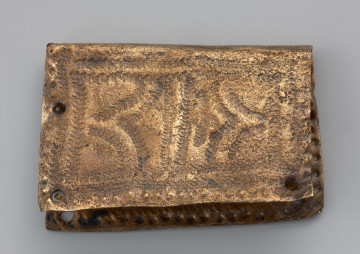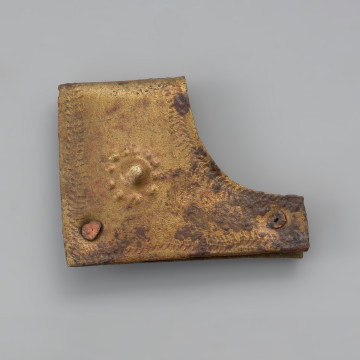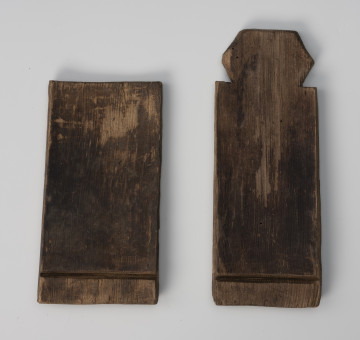
Leather sheath fitting
1001 — 1100
National Museum in Szczecin
Part of the collection: Middle Ages
Leather sheaths for knives and other sharp objects such as scissors were always made from a single piece of properly cut leather. Depending on the desired shape and size, it could be rectangular or trapezoid, less frequently square, folded in half. The simplest way of joining the edges was to sew with thread or thread the leather through pre-cut holes. Their even placement, the colour of the thong (thread or occasionally wire), impacted the aesthetics, being a kind of decoration. Another way of joining the edges of leather consisted in fastening them with rivets made of non-ferrous metal alloys, ordinary or decorative, placed additionally on square washers. The tightness of the sheath depended directly on the density of the rivets. The rivets were often accompanied by different shaped fittings, the so-called scabbard chapes reinforcing the lower parts of the sheaths, most exposed to direct contact with a sharp tool. An attractive and effective way to increase the aesthetic value was to place various plates on the sheath, not only of constructional or utilitarian significance. The rings attached to the sheaths - fittings in the middle parts - usually had only decorative functions. The shape and size of fittings depended on many factors. One of them was undoubtedly the social status and probably also the user’s wealth. Carefully decorated fittings often contained symbolic content, not always possible to read today. Nevertheless, such decorated sheaths should be considered above average. Over the centuries, the basic construction of the sheath remained the same, but the methods of stitching and decorating the sheath changed, depending on the general progress in the development of leatherwork and other areas of early medieval production. In the case of metal ornaments, local aesthetic trends and external influences are not without significance.
Anna Bogumiła Kowalska
Other names
bean solen
Author / creator
Dimensions
cały obiekt: height: 18.1 cm, width: 4.3 cm
Object type
knife scabbard, accessories
Technique
engraving, forging, riveting, casting, cutting, tanning
Material
non-ferrous metal, leather
Origin / acquisition method
field research
Creation time / dating
Creation / finding place
Owner
Muzeum Narodowe w Szczecinie
Identification number
Location / status

1001 — 1100
National Museum in Szczecin

1001 — 1100
National Museum in Szczecin

901 — 1200
National Museum in Szczecin
DISCOVER this TOPIC
Castle Museum in Łańcut
DISCOVER this PATH
Educational path